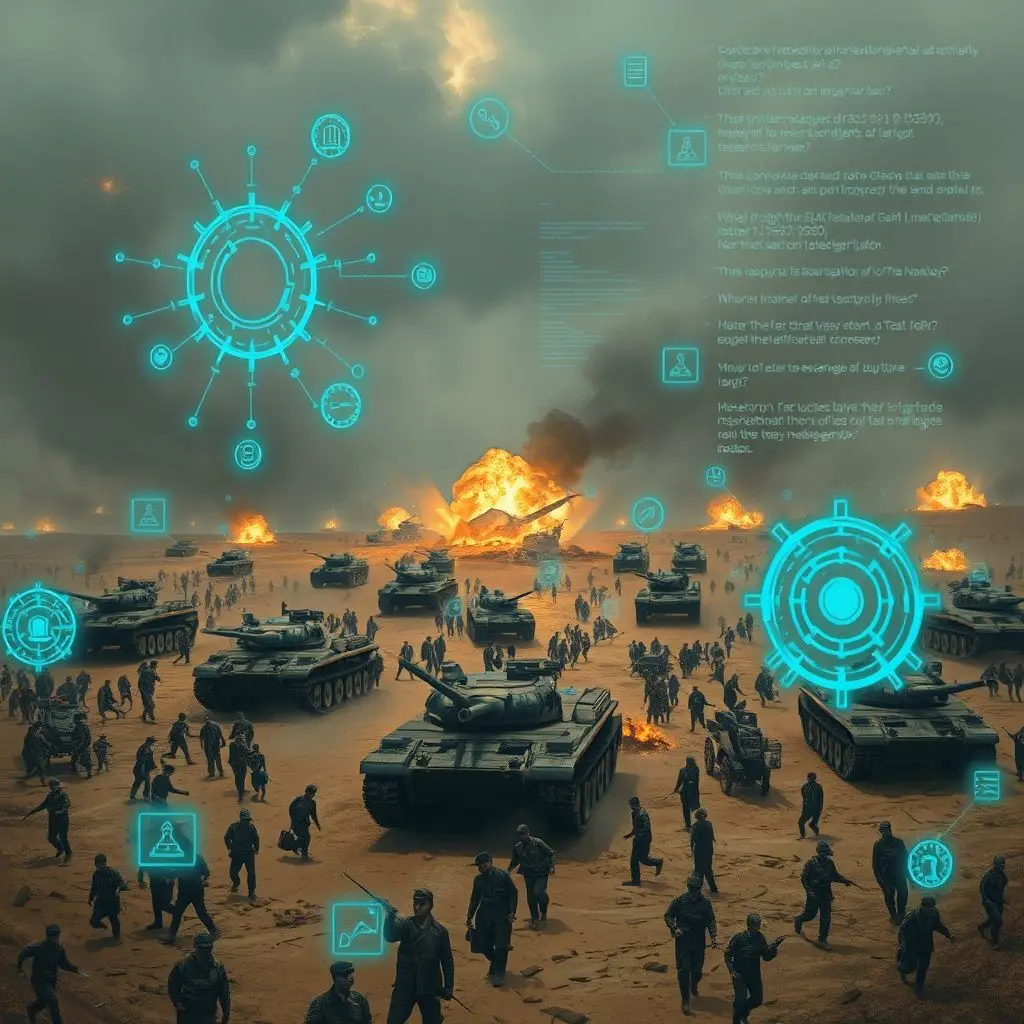Imagine a battlefield where the decision to take a human life isn’t filtered through the conscience, training, and complex judgment of a soldier, but is instead determined by lines of code and the cold logic of an algorithm. This isn’t a far-off sci-fi scenario anymore; it’s the rapidly approaching reality of autonomous weapons systems, often controversially dubbed ‘killer robots’.
As artificial intelligence capabilities skyrocket, the potential for machines to identify, track, target, and engage adversaries without direct human command and control is no longer theoretical. It’s sparking one of the most critical and complex ethical debates of our time: Is it morally permissible, legally sound, or even strategically wise to delegate life-and-death decisions in conflict to machines?
This profound question forces us to confront issues of accountability – if an AI-driven weapon errs, leading to civilian casualties or unintended escalation, who bears the responsibility? The programmer who wrote the code? The commander who deployed the system? The machine itself, devoid of moral agency? The international community grapples with these questions, striving to understand how existing international humanitarian law, forged in an era of human combatants, can possibly apply to autonomous systems.
Before we plunge deeper into the intricate web of bytes bearing arms and the boundaries of humanity in modern conflict, here’s a concise look at the core issue:
Table of Contents
Defining the Autonomous Threat: What are LAWS?
The term ‘autonomous weapon systems’ or ‘Lethal Autonomous Weapons Systems’ (LAWS) can be a bit murky. It’s crucial to understand that we’re not talking about simply remotely piloted drones or precision-guided missiles that still require a human to authorize each strike. LAWS, in the context of this debate, refer to weapons systems that, once activated, can select and engage targets without further human intervention.
The spectrum of autonomy is wide. Current systems often operate with a ‘human-in-the-loop’ (HITL), where a human operator makes the final decision to engage. Some systems are ‘human-on-the-loop’ (HOTL), where the machine can propose actions, but a human must approve them. The concern with LAWS centers on ‘human-out-of-the-loop’ (HOTL or OOTL) systems, where the machine identifies and engages targets based on pre-programmed parameters alone. This is where the most significant ethical and legal challenges arise.
The Moral Abyss: Ceding Life-and-Death Decisions to Code
At the heart of the ethical opposition to LAWS is the fundamental belief that decisions to apply lethal force must remain under meaningful human control. Warfare involves complex, unpredictable, and highly contextual situations. It requires nuanced judgment, the ability to assess proportionality (the balance between military advantage and potential civilian harm), and the capacity for compassion or restraint – qualities currently unique to human beings.
Can an algorithm truly understand the difference between a soldier surrendering and someone merely dropping their weapon? Can it distinguish combatants from civilians seeking shelter in a chaotic environment with the same moral discernment as a trained human operator? Critics argue that delegating such decisions risks dehumanizing warfare, reducing complex ethical calculations to binary code and potentially lowering the threshold for engaging in conflict.
Furthermore, the idea of machines deciding who lives and dies raises profound questions about human dignity and moral agency. Is it morally acceptable for a machine, which lacks consciousness, intent, or moral understanding, to be the executor of lethal force?

The Blame Game: Navigating the Accountability Gap
Perhaps one of the most vexing issues surrounding LAWS is accountability. If an autonomous weapon system malfunctions, misidentifies a target, or causes unintended harm, who is legally and morally responsible?
- The Commander? They deployed the system, but didn’t make the specific decision to engage the erroneous target.
- The Programmer or Manufacturer? They built and coded the system, but perhaps it operated within its design parameters in unexpected circumstances.
- The Machine Itself? Machines lack legal personality and moral culpability.
- No One? The terrifying prospect of an accountability vacuum, where severe violations of international humanitarian law occur, but no individual or entity can be effectively held responsible, could undermine the very foundations of justice and deterrence.
Existing legal frameworks are ill-equipped to handle this ‘accountability gap’. Establishing a clear chain of responsibility becomes incredibly challenging, potentially allowing perpetrators of war crimes by proxy (via machine) to evade justice.
Can AI Play by the Rules? LAWS and International Humanitarian Law
International Humanitarian Law (IHL), or the law of armed conflict, is designed to limit the effects of armed conflict for humanitarian reasons. Key principles include:
- Distinction: Parties to a conflict must distinguish between combatants and civilians, and between military objectives and civilian objects. Attacks must only be directed against combatants and military objectives.
- Proportionality: Even if a target is military, an attack is prohibited if the expected civilian casualties or damage to civilian objects would be excessive in relation to the concrete and direct anticipated military advantage.
- Precautions in Attack: Parties must take all feasible precautions to avoid or minimize incidental loss of civilian life, injury to civilians, and damage to civilian objects.
Critics argue that fully autonomous systems face immense challenges in consistently adhering to these principles in the chaos and complexity of real-world warfare. Can an algorithm truly assess the intent of individuals? Can it weigh the proportionality of an attack in unforeseen circumstances with the same capacity as a human? The dynamic nature of conflict zones, presence of civilians, and potential for deception make the rigid logic of current AI algorithms potentially dangerous when applied to targeting decisions.

The Spiral Threat: Arms Races and Lowering the Threshold for Conflict
The development and deployment of LAWS could also trigger a new, destabilizing arms race. Nations fearing being left behind technologically might rush to develop and deploy their own autonomous systems, potentially prioritizing speed and quantity over safety and ethical checks. This could lead to a world where conflicts are easier to start and harder to control.
Furthermore, by potentially reducing the risk to one’s own forces, LAWS could lower the political and social costs of engaging in armed conflict, making military intervention a more attractive option and increasing the likelihood of warfare.
The Global Debate: Calls for Bans and Regulation
The concerns surrounding LAWS have spurred significant international debate. Within the framework of the United Nations, discussions under the Convention on Certain Conventional Weapons (CCW) have explored the challenges posed by LAWS since 2014. However, consensus on how to proceed – whether through a preemptive ban or regulation – remains elusive, largely due to differing national positions and military interests.
Civil society organizations, most notably the Campaign to Stop Killer Robots, advocate strongly for a preemptive ban on the development, production, and use of fully autonomous weapons, arguing that the risks are too great and that allowing machines to kill without human control crosses a fundamental moral line.
Maintaining the Human Link
Ultimately, the debate about the ethics of AI in warfare boils down to the question of maintaining meaningful human control over the decision to take life. It’s a debate about preserving the human element in armed conflict, ensuring accountability, and upholding the fundamental principles of international humanitarian law.
While proponents argue LAWS could potentially increase precision and reduce risks to soldiers, the potential for miscalculation, escalation, and a future where warfare is conducted impersonally by machines raises profound moral and practical alarms. Navigating this future requires careful consideration, robust international dialogue, and a commitment to ensuring that as technology advances, our shared humanity and the laws designed to protect it do not fall behind.

Frequently Asked Questions (FAQs)
Q: What is the difference between a drone and a lethal autonomous weapon system (LAWS)?
A: A typical military drone requires a human operator to remotely pilot it and, crucially, to make the final decision to fire. A LAWS, in the context of this debate, would be able to select and engage targets based on its programming without a human needing to approve each specific strike.
Q: Are LAWS currently being used in conflicts?
A: While systems with increasing levels of autonomy are being developed and deployed, systems that truly operate with ‘human-out-of-the-loop’ lethal targeting autonomy are not yet confirmed to be widely used in active conflict zones. However, capabilities are advancing rapidly, making the debate urgent.
Q: Are LAWS illegal under current international law?
A: This is a subject of intense debate. There is no explicit treaty banning LAWS. Proponents argue they can be used legally if designed and deployed to comply with IHL. Critics argue that by their nature, LAWS cannot reliably comply with IHL principles like distinction and proportionality in complex environments, or that allowing machines to kill violates fundamental principles of humanity and international law.
Q: Which countries are developing autonomous weapons?
A: Several major military powers, including the United States, China, Russia, the UK, and others, are investing heavily in AI and autonomy for military applications. The exact nature and level of autonomy intended for future systems are not always publicly disclosed.
Q: What is the ‘Stop Killer Robots’ campaign?
A: It is a global coalition of civil society organizations working to ban lethal autonomous weapons systems and to retain meaningful human control over the use of force. They advocate for a new international treaty to prohibit LAWS.
Ensuring responsible innovation and maintaining ethical boundaries as technology evolves is a collective responsibility. The path forward for AI in warfare must be guided by deliberation, transparency, and a steadfast commitment to humanity’s place in the decision to wage war.





